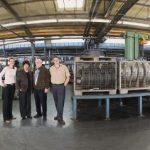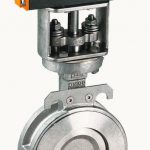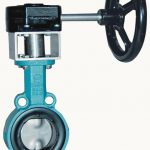With an annual turnover in 2005 of almost 87 million euros, the family-run enterprise Ebro Armaturen, founded in 1972, has established itself as a market leader in the area of valve and actuator production. The acquisition of Swedish knife gate valve specialist Stafsjö represents a further milestone in the Bröer Group’s immensely successful corporate history. cpp spoke with Managing Director Peter Bröer about the acquisition and the highlights for Achema 2006.
cpp: Which considerations led to the acquisition of Stafsjö?
Peter Bröer: Since the company’s inception, we have always followed the philosophy of a “Made by Ebro” product range, and as far as possible refrained from buying in products from external sources. Against the background of worldwide growth, the internationalisation of markets and the development of new target sectors, we decided to introduce knife gate valves to our portfolio. At the time when we were considering a corporate acquisition, Stafsjö was listed on the Stockholm exchange as a member of the Bejier Alma Group. In addition, the Stafsjö brand, after more than 100 years of knife gate valve production, was very well established in the marketplace, boasting superior prod-uct availability, reliability and cost efficiency. The choice was an easy one.
cpp: What is the significance of the name Stafsjö?
Peter Bröer: Stafsjö is the name of a small Swedish town, 140 km south of Stockholm, where the company is still based to this day. Stafsjö Valves AB has a long history that is rich in tradition. The development and production of knife gate valves began back in 1885. Today, the company focuses on process technology and has positioned itself specifically in the market of the paper and pulp industry. Production primarily takes place in Sweden. The company manufactures approximately 20,000 knife gate valves a year, with more than 80 % destined for export. Stafsjö has its own branches in Germany, Austria and China, and the product portfolio is marketed by well-known commercial partners in other countries.
cpp: Why doesn’t Stafsjö now operate under your core brand, Ebro Armaturen?
Peter Bröer: Our strategy is to bring together two strong brands under one roof. For customers, Stafsjö and Ebro Armaturen will thus continue to exist as independent companies. The amalgamation of Stafsjö focusing on the paper and pulp industry and Ebro Armaturen as a recognised partner in industry and building technology will enhance our overall expertise, as well as boosting our image and accelerating technology transfer. This will provide us with the necessary know-how to position ourselves better in different market segments and compete with conglomerates. Our range of valves will also be extended, helping us to develop new markets and customers through a broader product competence. In short, we will be competitive and flexible with an all-embracing product spectrum, and better able to utilise the growth potential of the various markets.
cpp: Achema opens its doors from 15 to 19 May 2006. Which highlights are you preparing for your visitors?
Peter Bröer: We have continuously enhanced our product range. We presented our first production series for large-scale chemical operations at Valve World 2004 in Maastricht. All product series exhibited at this year’s Achema fulfil the requirements for critical applications in the chemical and petrochemical industry. Both valve design and material selection conform to the technical specifications of large chemical companies. We are certified to ISO 9001 and the Pres-sure Equipment Directive and fulfil all harmonised standards. Naturally, national standards have also been taken into account. We have taken the requirements and installation guidelines of TA-Luft 2002 very seriously indeed and adapted the design of our product range accordingly. The equivalence of our seal systems to a bellows-type stem seal has been certified by RWTÜV.
cpp: Are there also innovations in the area of valve automation?
Peter Bröer: In the field of automation technology we have achieved a cost-effective solution for the final control devices, whilst observing the permissible stem loading, by optimising the initial breakaway torques. The interface between the valve, bracket and actuator is already designed in accordance with DIN EN 15081. At Achema we will present the completely revised second generation of our proven Scotch Yoke actuator as well as a new Rack & Pinion actuator series, which is designed for valves with smaller nominal widths and for spring-actuated types. These actuators are also suitable for backlash-free control functions. In addition, we have developed a Pressure Control Device (PCD) in collaboration with Fraunhofer UMSICHT (Fraunhofer Institute for Environmental, Safety and Energy Technology), designed to prevent damages due to pressure surges and cavitation impacts. Today, 10 % of major dam-ages to pipes and valves are caused by excessive pressure surges, preventing consistently reliable and optimal operation. Our pressure controller has been successfully tested on a test set-up at Fraunhofer Institute and developed to series-production readiness.
cpp: Everyone is talking about life cycle costs. You are currently carrying out in-depth studies on this rather theoretical topic. What have you achieved to date?
Peter Bröer: The life cycle cost analysis focuses on investment costs in relation to operating costs and shows that low-cost purchases do not necessarily pay in the long-term. In principle, an in-depth study of life cycle costs is particularly recommended in applications where, for example, abrasive or aggressive media, sometimes with a high solids content or high viscosity, are transported. These media cause heavy wear and extreme corrosion of the valve. It is striking that the investment costs represent the lowest expenditure here, when compared with subsequent costs such as repair costs, purchases of spare parts or even costs associated with production stoppages. Due to cost streamlining in many companies, the relationship between investment and consequential costs is often neglected. In some cases, customers wonder whether quality is still actually worth the effort. For us, as a manufacturer of high-quality valves, the life cycle cost analysis is an additional service aimed at providing customers with a calculation of the service life and any potential downstream costs associated with the use of our products at the time of purchase.
cpp: What do you hope to achieve at Achema 2006?
Peter Bröer: A very strong response to our innovations and next-generation developments in the product and service divisions, as well as a broad exchange of ideas. No other trade show provides such comprehensive information as Achema. We hope that Achema continues to be a trend-setting and pioneering information platform both for visitors and for us as exhibitors.
Hall 8, Booth E11
cpp 408
Direkt zu den Produkten
Schwedische Armaturen
VDMA Fachverband Armaturen
Achema 2006
Share:










